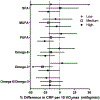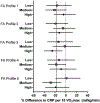Omega-3 polyunsaturated fatty acids modify the inverse association between systemic inflammation and cardiovascular fitness
- PMID: 33618966
- PMCID: PMC8243787
- DOI: 10.1016/j.clnu.2021.02.006
Omega-3 polyunsaturated fatty acids modify the inverse association between systemic inflammation and cardiovascular fitness
Abstract
Background and objective: Exercise increases quality of life and lowers all-cause mortality, likely by preventing cardiovascular disease. Although the beneficial effects of exercise are linked with reductions in chronic inflammation, individual responses vary and factors that contribute to the anti-inflammatory effects of cardiovascular fitness remain largely undefined. We sought to investigate the role of fatty acids in the inverse relationship between inflammation and cardiovascular fitness.
Approach and results: In this cross-sectional study using data from 435 participants in NHANES and linear regression models with CRP as the outcome, we observed significant negative interactions between VO2max and omega-3 polyunsaturated fatty acids (PUFAs) but not saturated, monounsaturated, or omega-6 PUFAs. When stratified by omega-3 PUFA tertiles, participants in the medium tertile, but not low tertile, show an enhanced negative association between VO2max and CRP, with a -32.0% difference (95% CI: -44.95, -15.9%) per 10 mL/kg/min of VO2max. Exploratory factor analysis identified five unique dietary fatty acid (FA) profiles. The FA profile consisting predominantly of omega-3 PUFA had the strongest negative association for VO2max and CRP, with a -28.2% difference in CRP (95% CI: -43.4, -8.9) per 10 mL/kg/min of VO2max. We also found that alpha-linolenic acid (ALA) and docosahexaenoic acid (DHA) enhanced the negative association between VO2max and CRP, suggesting that the anti-inflammatory response to VO2max capacity is associated with ALA and DHA levels. Males, Whites, and individuals with lower BMI were more sensitive to the effects of omega-3 PUFAs, while having high SFA levels attenuated the benefit.
Conclusions: This study suggests that omega-3 PUFAs are effect modifiers for VO2max and CRP and that the anti-inflammatory benefits of increasing cardiovascular fitness are associated with omega-3 PUFAs.
Keywords: CRP; Cardiovascular; Exercise; Inflammation; Omega-3.
Copyright © 2021 Elsevier Ltd and European Society for Clinical Nutrition and Metabolism. All rights reserved.
Conflict of interest statement
Conflicts of interest Authors declare no conflicts of interest.
Figures






Similar articles
-
Intakes of PUFAs were inversely associated with plasma C-reactive protein 12 years later in a middle-aged population with vitamin E intake as an effect modifier.J Nutr. 2013 Nov;143(11):1760-6. doi: 10.3945/jn.113.180943. Epub 2013 Sep 11. J Nutr. 2013. PMID: 24027184 Clinical Trial.
-
Systemic immune inflammation mediates the association of serum omega-3 and omega-6 polyunsaturated fatty acids with biological aging: a national population-based study.Aging Clin Exp Res. 2025 Mar 8;37(1):74. doi: 10.1007/s40520-025-02964-2. Aging Clin Exp Res. 2025. PMID: 40057623 Free PMC article.
-
Serum Polyunsaturated Fatty Acid Composition and Serum High-Sensitivity C-Reactive Protein Levels in Healthy Japanese Residents: The KOBE Study.J Nutr Health Aging. 2015 Aug;19(7):719-28. doi: 10.1007/s12603-015-0497-9. J Nutr Health Aging. 2015. PMID: 26193854
-
Effects of Dietary n-3 and n-6 Polyunsaturated Fatty Acids in Inflammation and Cancerogenesis.Int J Mol Sci. 2021 Jun 28;22(13):6965. doi: 10.3390/ijms22136965. Int J Mol Sci. 2021. PMID: 34203461 Free PMC article. Review.
-
n-3 Polyunsaturated fatty acids for the management of alcoholic liver disease: A critical review.Crit Rev Food Sci Nutr. 2019;59(sup1):S116-S129. doi: 10.1080/10408398.2018.1544542. Epub 2018 Dec 22. Crit Rev Food Sci Nutr. 2019. PMID: 30580553 Review.
Cited by
-
The association of organophosphate flame retardants (OPFRs) exposure on omega-3 fatty acids metabolism: evidence derived from the United States general population.Toxicol Res (Camb). 2025 Aug 17;14(4):tfaf119. doi: 10.1093/toxres/tfaf119. eCollection 2025 Aug. Toxicol Res (Camb). 2025. PMID: 40827232 Free PMC article.
-
α-Linolenic Acid and Risk of Heart Failure: A Meta-Analysis.Front Cardiovasc Med. 2022 Jan 4;8:788452. doi: 10.3389/fcvm.2021.788452. eCollection 2021. Front Cardiovasc Med. 2022. PMID: 35059448 Free PMC article.
-
Exercise-Stimulated Resolvin Biosynthesis in the Adipose Tissue Is Abrogated by High-Fat Diet-Induced Adrenergic Deficiency.Arterioscler Thromb Vasc Biol. 2025 Jul;45(7):1090-1110. doi: 10.1161/ATVBAHA.124.322234. Epub 2025 May 8. Arterioscler Thromb Vasc Biol. 2025. PMID: 40336478 Free PMC article.
-
Dose-Dependent Effects of Dietary n-3 Fatty Acids on Bowel Health: Plant-Sourced ALA Modulates Diarrhea Risk While Marine-Sourced DHA/EPA Prevent Constipation in NHANES 2005-2010.Food Sci Nutr. 2025 Aug 6;13(8):e70769. doi: 10.1002/fsn3.70769. eCollection 2025 Aug. Food Sci Nutr. 2025. PMID: 40772019 Free PMC article.
-
The association between the dietary inflammatory index and cardiorespiratory fitness in United States young adults: a cross-sectional study from the National Health and Nutrition Examination Study, 1999-2004.Front Nutr. 2024 Sep 26;11:1442710. doi: 10.3389/fnut.2024.1442710. eCollection 2024. Front Nutr. 2024. PMID: 39391678 Free PMC article.
References
-
- Fedewa MV, Hathaway ED, Ward-Ritacco CL. Effect of exercise training on C reactive protein: a systematic review and meta-analysis of randomised and non-randomised controlled trials. Br J Sports Med 2017;51:670–6. - PubMed
-
- Pedersen BK, Saltin B. Exercise as medicine - evidence for prescribing exercise as therapy in 26 different chronic diseases. Scand J Med Sci Sports 2015;25(Suppl 3):1–72. - PubMed
-
- Pedersen BK. Anti-inflammatory effects of exercise: role in diabetes and cardiovascular disease. Eur J Clin Invest 2017;47:600–11. - PubMed
Publication types
MeSH terms
Substances
Grants and funding
LinkOut - more resources
Full Text Sources
Other Literature Sources
Research Materials
Miscellaneous

